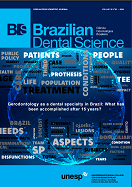Clinic and Cone beam computed tomography characterization of the bone maxilofacial lesions from Estomatology Clinic
DOI:
https://doi.org/10.14295/bds.2016.v19i2.1244Abstract
Objetivo: Caracterizar as lesões ósseas da região maxilofacial conjugando seus aspectos clínicos aos imaginológicos, por tomografia computadorizada de feixe cônico (TCFC), comparando estes achados da literatura. Material e Métodos: Foram selecionados 12 prontuários da Clínica de Propedêutica Estomatológica do ICT-UNESP, apresentando lesões ósseas na região maxilofacial, com prévia indicação de exame por TCFC, realizados em tomógrafo i-CAT Next Generation (imaging Sciences International, Hatfield, PA, EUA) na clínica de Radiologia da instituição. Foram levantadas informações clínicas como sexo, faixa etária e queixas principais. Avaliou-se as imagens de TCFC quanto: localização, arquitetura interna e limites da lesão, efeito nas corticais ósseas, efeito nos dentes e estruturas de suporte dentário e os aspectos internos da lesão. As imagens foram avaliadas no software i-CAT Vision do tomógrafo em janelas de reconstrução multiplanar (MPR). Resultados: Foram estudadas 04 lesões correspondentes a cistos radiculares, 02 a tumores odontogênicos queratocísticos, 01 a odontoma composto, 01 a hamartoma odontogênico, 01 a displasia óssea focal, 01 tumor odontogênico cístico calcificante e 02 cicatrizes fibrosas. A TCFC auxiliou na conclusão dos diagnósticos, visto sua característica de tridimensionalidade, houve, algumas vezes, divergências em relação aos achados descritos na literatura, eminentemente baseados radiografias bidimensionais. Conclusão: a TCFC é de grande valia na caracterização das lesões ósseas, observa-se uma necessidade na literatura de uma abordagem específica para esta modalidade de imagens, diferente das radiográficas convencionais.
Downloads
Downloads
Published
How to Cite
Issue
Section
License
Brazilian Dental Science uses the Creative Commons (CC-BY 4.0) license, thus preserving the integrity of articles in an open access environment. The journal allows the author to retain publishing rights without restrictions.
=================




























